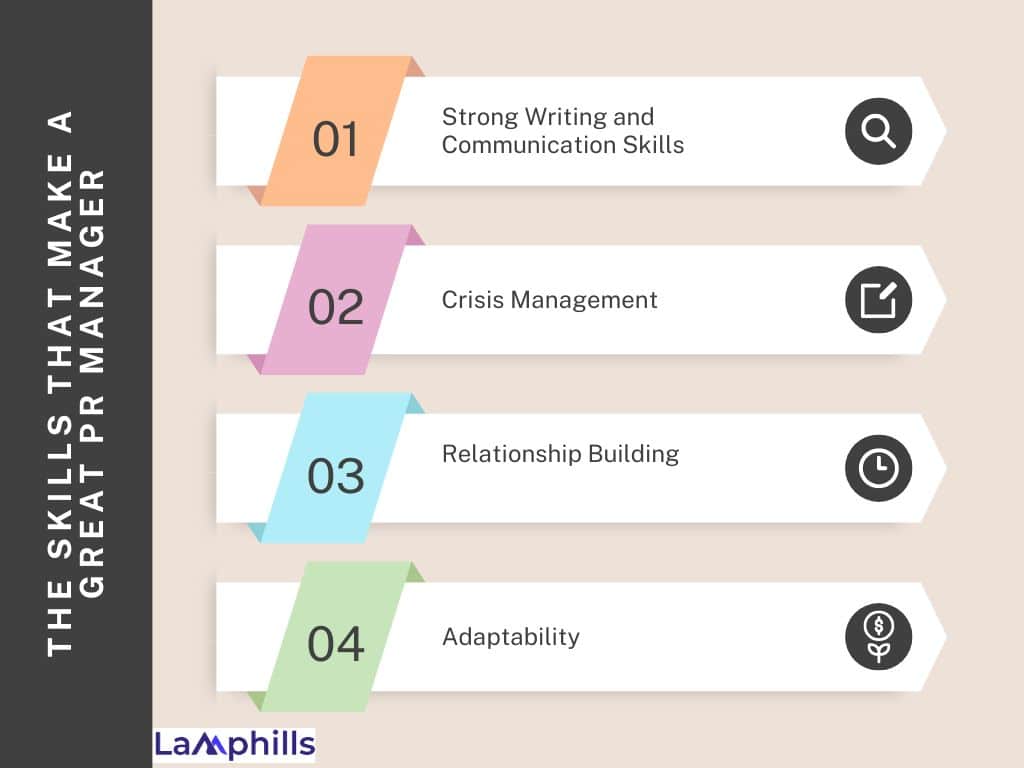Ever wondered what goes on to keep a brand in focus and, more importantly, in people’s good books when something in the company goes awry? Behind the curtain of such a balancing act stands the PR Manager. Call them a superhero, if you like, of any brand, working day in and day out to not only ensure his or her company comes into the people’s view but also gets loved. From handling crisis communications to crafting the required narratives, their role has become indispensable in shaping and maintaining an image for the company in front of the world. Let’s dive into the key responsibilities of a PR manager.
Key Points
- PR Managers liaise between the brand and media, drafting press releases, pitching stories, and building relationships to secure favorable coverage.
- PR Managers are responsible for producing various types of content, including press releases and social media updates, ensuring that the messaging aligns with the company’s values and engages the audience.
- They shape and communicate the brand’s image by developing coherent messaging strategies that resonate with the company’s audience and reflect its core values.
- PR Managers plan and execute events such as product launches and charity galas to enhance the brand’s visibility and reputation, ensuring every detail contributes positively to the brand’s public perception.
Who is a PR Manager?
A PR Manager, or Public Relations Manager, is concerned with maintaining the perception of the public towards a brand or institution. They do everything, from the work of media relations and press releases to crisis management to event organization. Think of them as a guard of the reputation of an organization. The aim is to keep the image positive while the voice is consistent, trusted, and engaging.
Now, put yourself in a position whereby every day, driving to work, you don’t know what headline might pop up about your company. It could be fantastic news, or it could be a crisis that damages the company’s image. That’s where a PR manager comes in; they’re always on their toes to respond, protect, and polish the brand’s reputation.
PR Manager is a mid management position that aims at presenting a positive image of the employer or client through the management of programs, accomplishment or points of view.
Although they may also work for public relations firms, public relations managers usually support their employers’ brand image by working for corporations across industries. They supervise the preparation of announcements for product recalls, new product launches, management changes, and other significant business news in close collaboration with marketing specialists and higher management. Monitoring local, national, or worldwide news coverage is part of their job to ascertain how the public views their business or responds to assertions made by media representatives.
Additionally, they create media plans for other business events, such as manufacturing mistakes, employee litigation, business growth, or humanitarian endeavors.
Job Description of PR Manager
The role of a PR manager is multifaceted. They act as both strategist and storyteller, ensuring that every message the brand communicates serves a purpose. Below are the key responsibilities that make up the job description for a PR Manager.
#1. Media Relations
One of the most important roles a PR Manager plays involves managing media relations. They are the connecting link between the brand and the media, drafting press releases, pitching stories to journalists, and building relationships with reporters. A good relationship with the media promises more favorable coverage and allows the brand to reach a wider audience.
- Example: At one point in my career as a former PR Manager, I had to convince a top journalist to give my press release for a product launch the proper amount of coverage. It is all about learning how the publishing is done in such a way that it favors the brand as well as the media.
#2. Crisis Management
When things go wrong, the PR Manager is that hero who comes to sort things out. Whether the firm faces a product recall, sees negative media coverage or the company’s social media pages go up in flames, it is the PR Manager’s responsibility to avert such an outcome. This they do by developing crisis communication plans which assist in the minimization of damage and the defending of the brand.
- Example: Think of how companies like United Airlines or Pepsi had to deal with viral PR crises. These situations were handled by PR professionals who implemented carefully crafted responses to manage public perception.
#3. Content Creation
PR Managers ensure that the company’s message corresponds to the company’s values because content creation is likewise a part of this position. They create press releases, blog posts, social media updates speeches, and even website content. The tone and message are very important and must be well placed and the time is also very critical.
- Example: As a former PR Manager for a brand, I once wrote a press release for a tech company wherein they announced signing a partnership agreement. What it wasn’t, was a dry reciting of the facts, it was making people feel that the story was exciting.
#4. Brand Messaging and Strategy
In general, a PR Manager is tasked with shaping and communicating the relevant brand image. It entails coming up with basic conversation questions and tones that are to be adopted to ensure that various policies are coherent. They make sure that the company has the right story to portray and this story is correct in terms of the values provided to the company’s fans.
- Example: When Coca-Cola launched the “Share a Coke” campaign, it was not about selling Coke or soda. It was about giving people a link and the PR strategy made sure that the message was passed on to everyone.
A detailed checklist of how a PR Manager can ensure consistent brand messaging and strategy through several key practices
#5. Event Coordination
Many public relations managers plan and coordinate activities that could increase the profile of a brand. This may comprise new product releases and media appearances, such as press releases, galas charity work, or big trade fairs. An event can go well and gain appreciation, especially in the eyes of the media.
- Example: As a former PR Manager, when I worked on a brand’s charity gala, every detail mattered, from the guest list to media invitations. It wasn’t just about the event itself, but how it would reflect on the brand’s commitment to giving back.
#6. Social Media Management
These days, everyone must have a strong social media presence. PR Managers are in charge of approaches to social media, image, and followers. They listen to what people are saying about the brand and make sure that the company’s message is well relayed.
- Example: At the time Wendy’s started its trend on Twitter, it was a humorous and sassy social media advertisement. It is important to note that every tweet was purposeful, humorous, and consistent with the brand’s branding and image.
#7. Influencer and Stakeholder Management
PR Managers equally engage with influencers and other relevant stakeholders to get across the brand message. They can leverage such networks to draw more traffic to the website while at the same time gaining more brand popularity.
- Example: I have a PR Manager friend who used to work for a fitness brand that hired influencers to help advertise a new product. The right influencer partnership led to a viral campaign that boosted sales significantly.
The Skills That Make a Great PR Manager

- Strong Writing and Communication Skills: PR Managers must write compelling press releases, speeches, and social media posts. As a result, a PR Manager needs to be a little bit of everything for him or her to be effective. They should possess good communication skills, be creative, possess strategic thinking, and ability to multitask. There is nothing as powerful as ink when it comes to passing messages as all it takes is good writing skills.
- Crisis Management: PR crises are certain to occur and, therefore, it is important to understand how to perform well under pressure.
- Relationship Building: Building relationships with journalists, influencers, and stakeholders is critical for getting the brand’s message out there.
- Adaptability: Fortunately, the media landscape is constantly evolving, and a PR Manager needs to stay on top of trends and adjust strategies accordingly.
Public Relations Manager Knowledge Requirements: Education and Training
A Public Relations Manager must have a bachelor’s degree in media and communications, English, journalism, marketing, or any related course. While having a master’s degree in media, marketing or another related field may be helpful, it is not required.
There are also some certifications one can acquire while practicing as a Public Relations Manager. One of them is the APR Credential offered by the Universal Accreditation Board and the other is the Public Relations Society of America Certification. An applicant must have a minimum of five years of experience and he or she will also need to complete the computer-based exam. Another one is the Accredited Business Communicator certification given by the International Association of Business Communicators. This is achieved via nine years of education and work experience and involves a written and oral examination. Skills training may also be relevant because managing a team may be an important part of this role. A certification or short course in people management will be useful.
Public Relations Manager Qualification: Education, Skills, & Experience
A qualified Public Relations Manager will be expected to have at least five years of experience in the public relations industry. He will also need to have at least two years of experience managing a PR team. A Public Relations Manager must have some past accomplishments in coming up with press releases and other publicity items. They should know how to develop marketing and content strategies, and how to apply them effectively.
What Does a PR Person Do?
A public relations officer or public relations specialist is in charge of how a company or person is viewed. They write and disseminate press releases. Also, they engage the media. Moreover, they provide crisis communication, as well as attempt to put out positive messages for those they represent. Finally, they ensure they keep tabs on public opinion, engage on social media platforms, and establish relationships that benefit the brand.
What Is the Role of a Marketing and PR Manager?
As part of their career, a Marketing and PR Manager both market a company and handle its public relations. They design and launch marketing communications campaigns that are suitable to the brand image that they represent as well as guarantee the message consistency across various platforms. As a part of this position, one should have good management of promotional campaigns, media relations, public events, and advertising teams. They are supposed to increase the popularity of the brand and create a successful partnership between the company and the target group.
What Skills Do You Need for PR?
For one to work in this field, he/she requires skills in content writing specifically in press releases. And articulate when interacting with the media and stakeholders. Crisis intervention is important for dealing with crises while imagination enables good storytelling. Many times, cooperation and trust are important with media and influencers along with building close connections with the clients. PR professionals also must have social media knowledge to handle an organization’s image on these websites and strategic thinking skills to incorporate PR with overall business strategy.
What Is the Objective of a PR Manager?
PR Manager’s main goal is to protect and build the image of the company or the brand in the eyes of the public/ audience. It covers controlling the organization’s image in media, maintaining its positive image, and successfully handling negative publicity when it occurs. The principles aim at the establishment of a profession among the public audience. Likewise, the promotion of the brand image, and the coordination of PR initiatives with business prospects for sustainable development.
Conclusion
Being a PR Manager is no small task. It’s a role that requires wearing many hats, from crafting compelling narratives to managing crises and coordinating events. But the rewards are huge. You’re not just managing the brand’s image; you’re helping shape how the world perceives the company.
So, if you’re thinking of stepping into the shoes of a PR Manager, or if you’re already in the role, follow these insights to guide your way. Thanks for reading to the end, and remember: a good PR strategy can make all the difference in how your brand is perceived!
Related Posts
- PR Manager: Job Description and Key Responsibilities (+ Free Job Description Template)
- What Does a CRM Manager Do? Key Duties and Best Practices
- Your Ultimate Guide to Effective Stakeholder Management: Best Practices
References






